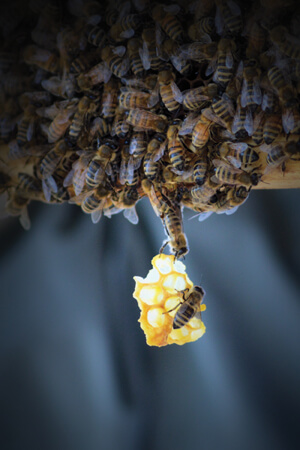
“HOLD ON”
Please consider this photo for inclusion in your magazine. It was taken by Jennifer Clutts in Anchor Point, Alaska. Thank You.
Jesse R. Clutts
Hive maintenance as an athletic event
What a timely and informative article (June issue) on why I can’t inspect more than 3 hives without giving out. The idea of staggered feet to help keep your spine straight has proven immensely helpful to me. Suggesting a straight back chair has allowed me to spend more time with each hive instead of rushing through the last 2 or 3 hives. I am more relaxed and able to concentrate on why I’m in the hive in the first place. Getting those hives up where we can see them is a lot better than leaning over with your face in the ground.
We need more articles about the welfare of the beekeeper. Jessica Kern has been a back saver for me and several of my beekeeping friends.
Allen Majefski
Dallas, TX
A New Bacterial Infection in Honey Bees?
In the April 2017 Classroom column of the American Bee Journal, a question was raised by a reader about our study at the University of Wisconsin-Stout reporting the finding of Serratia marcescens in honey bees. As the principal investigator for that effort, I was fortunate to work with several talented researchers and a number of motivated students that led to the publication of our work. Because the response to the question in the column contained incorrect information, I have prepared a summary of our report below.
Septic bees were found separated from the winter cluster:
In December of 2014, we observed large numbers of bees immobilized between the inner and outer cover of certain hives in Dunn County Wisconsin. During that time, daytime temperatures remained below freezing, and bees were confined to the hives. The immobilized bees were separated from the winter cluster and showed no sign of movement when collected. However, when the bees were warmed to room temperature, many regained sluggish crawling activity but were unable to fly. We collected hemolymph from those living bees for further study. Hemolymph is a fluid in the circulatory system of insects which has some similarity to blood in humans.
The immobilized bees were septic:
Microscopy of the hemolymph from the immobilized living bees revealed numerous bacteria. That observation suggested the bees had sepsis, which involves a bacterial infection of the circulatory system. In humans, untreated sepsis is usually fatal. The concentration of the bacterium in the hemolymph of the live bees was about one million-fold higher than the level of different bacteria in human blood that can cause fatal infections. In certain hives we examined, greater than 90% of the living bees separated from the winter cluster were septic. We also found those bees had a significant loss of immune cells called hemocytes, which are normally present in the hemolymph to help bees fight infection.
The bees were infected with a novel bacterium:
Genetic analyses of the bacterium we isolated showed it belongs to a group of organisms known as Serratia marcescens. However, our studies indicated it had a sufficient amount of unique DNA to constitute a new strain of that organism. The organism we isolated also contained 65 additional genes not found in any other strain of Serratia examined. In addition, the growth characteristics showed a number of ways in which this bacterium is not typical of other S. marcescens. Because of the differences between the S. marcescens we isolated from the septic bees and the other strains of S. marcescens examined, we proposed the name S. marcescens strain sicaria for this new organism, and referred to it as Ss1 in our study.
Ss1 is not generally found in normal bees:
Unlike the situation during winter, workers showing symptoms of Ss1 infection could not be found during warm months when bees were flying. Throughout the year, only about 3% of the active bees in the hive were found to


